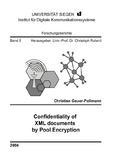Citation link:
https://nbn-resolving.org/urn:nbn:de:hbz:467-647| Dokument Type: | Doctoral Thesis | metadata.dc.title: | Confidentiality of XML documents by pool encryption | Authors: | Geuer-Pollmann, Christian | Institute: | Fachbereich 12, Elektrotechnik und Informatik | Free keywords: | XML security, Encryption, Pool Encryption | Dewey Decimal Classification: | 004 Informatik | GHBS-Clases: | TVBC | Issue Date: | 2004 | Publish Date: | 2005 | Source: | Zugl. ersch.: Aachen: Shaker, 2004 ISBN 3-8322-2846-2 | Abstract: | The eXtensible Markup Language (XML) is a widely adopted format for documents containing structured information. Structured information contains both the content (words, images etc.) and the ‘markup’ which indicates the role of the content, e.g. ‘section’ or ‘price’. XML is the foundation for a huge variety of existing and emerging applications, including user applications like vector imaging formats, web pages, enterprise application integration, database interfaces or network protocols. Parallel to the increasing use of XML, the level of security provisions for these XML based systems rises. The World Wide Web Consortium (W3C) addressed these issues by creating the “XML Signature Syntax and Processing” and “XML Encryption Syntax and Processing” recommendations. These standards define authentication, integrity and confidentiality mechanisms for XML documents. The XML Signature recommendation defines a method for digitally signing arbitrary portions (nodes) of an XML document. XML Signature can sign both tree structures and arbitrary sets of nodes of an XML document. The XML Encryption recommendation specifies a method for encrypting tree structures in an XML document. The XML Encryption recommendation is constrained to protect full tree structures, i.e. there is no mechanism to protect the confidentiality of a single node in a document without affecting the descendants of that node. The access control community transformed access control models originating in database systems to be available for XML based databases. These access control systems offer fine-grained access control enforcement on the node level, similar to the node level integrity protection of XML Signature. For example, XML Access Control systems can restrict the read access to a particular node in an XML tree while allowing access to its child nodes. This thesis is focused on the development of a cryptography based system which can protect the confidentiality of arbitrary nodes in an XML tree. This goal is reached by combining a tree addressing scheme of databases with cryptographic mechanisms. This system is called “XML Pool Encryption”. To verify the results of this thesis, XML Pool Encryption has been implemented using the Java programming language. Die eXtensible Markup Language (XML) ist ein weit verbreitetes Format für Dokumente, die strukturierte Information enthalten. Strukturierte Information umfasst sowohl den eigentlichen Inhalt (z.B. Wörter, Bilder, etc.) sowie Auszeichnungsinformation, um die Rolle der Inhalte zu umschreiben, z.B. “Überschrift” oder “Preis”. XML bildet die Grundlage für eine große Anzahl existierender und im Entstehen begriffener Anwendungen, wie z.B. Vektorgrafik-Formate, Web Seiten, Enterprise Application Integration Systeme, Datenbank Schnittstellen oder Netzwerkprotokolle. Parallel zur steigenden Verbreitung von XML werden immer mehr Vorkehrungen zum Schutz der auf XML basierenden Systeme notwendig. Das World Wide Web Consortium (W3C) hat sich dieser Notwendigkeit angenommen, indem die “XML Signature Syntax and Processing” und die “XML Encryption Syntax and Processing” Empfehlungen verabschiedet wurden. Diese Standards definieren Mechanismen für Authentisierung, Integrität und Vertraulichkeit von XML Dokumenten. Die XML Signature Recommendation definiert einen Mechanismus, um beliebige Teile eines XML Dokumentes (Nodes) digital zu signieren. XML Signature kann sowohl Baumstrukturen als auch beliebig geformte Knotenmengen eines XML Baumes schützen. Die XML Encryption Recommendation definiert einen Mechanismus für das Verschlüsseln von Baumstrukturen innerhalb eines XML Dokumentes. W3C XML Encryption ist hierbei auf die Verschlüsselung kompletter Baumstrukturen beschränkt, d.h. es existiert keine Möglichkeit, die Vertraulichkeit für einzelne Knoten im Dokument zu gewährleisten, ohne dass die Kinder dieser Knoten ebenfalls geschützt werden. Für die Zugriffskontrolle von XML basierten Daten wurden Zugriffsschutzmodelle aus dem Datenbankbereich überarbeitet. Diese Systeme bieten die Durchsetzung fein granularer Zugriffskontrolle auf Knotenebene, ähnlich dem Integritätsschutz beliebiger Knoten bei XML Signature. So ist es beispielsweise möglich, den Lesezugriff auf einen Knoten zu verweigern, während die Kinder dieses Knotens weiterhin lesbar bleiben. Im Mittelpunkt dieser Arbeit steht die Entwicklung eines auf kryptografischen Verfahren basierenden Systems, welches die Vertraulichkeit für beliebige Knoten eines XML Baumes gewährleistet. Dieses Ziel wurde durch die Kombination eines Schemas für die Adressierung von Baumstrukturen mit kryptografischen Verfahren erreicht. Dieses System wird “XML Pool Encryption” genannt. Zur Überprüfung der Resultate dieser Arbeit wurde XML Pool Encryption in Java implementiert. |
Description: | Schriftenreihe: Forschungsberichte / Universität Siegen, Institut für Digitale Kommunikationssysteme ; 9 |
URN: | urn:nbn:de:hbz:467-647 | URI: | https://dspace.ub.uni-siegen.de/handle/ubsi/64 | License: | https://dspace.ub.uni-siegen.de/static/license.txt |
| Appears in Collections: | Hochschulschriften |
This item is protected by original copyright |
Page view(s)
818
checked on Jan 8, 2025
Download(s)
297
checked on Jan 8, 2025
Google ScholarTM
Check
Items in DSpace are protected by copyright, with all rights reserved, unless otherwise indicated.


